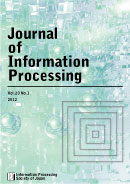Volume 24, Issue 3
Displaying 1-16 of 16 articles from this issue
- |<
- <
- 1
- >
- >|
-
Article type: Special Issue of Understanding, Technology, and Application of Interaction
2016 Volume 24 Issue 3 Pages 450
Published: 2016
Released on J-STAGE: May 15, 2016
Download PDF (38K) -
Article type: Special Issue of Understanding, Technology, and Application of Interaction
Subject area: System Security
2016 Volume 24 Issue 3 Pages 451-459
Published: 2016
Released on J-STAGE: May 15, 2016
Download PDF (1477K) -
Article type: Special Issue of Understanding, Technology, and Application of Interaction
Subject area: Music Information Processing
2016 Volume 24 Issue 3 Pages 460-468
Published: 2016
Released on J-STAGE: May 15, 2016
Download PDF (11331K) -
Article type: Special Issue of Extensions and Advances in Music Information Processing
2016 Volume 24 Issue 3 Pages 469
Published: 2016
Released on J-STAGE: May 15, 2016
Download PDF (34K) -
Article type: Special Issue of Extensions and Advances in Music Information Processing
Subject area: Music Information Processing
2016 Volume 24 Issue 3 Pages 470-482
Published: 2016
Released on J-STAGE: May 15, 2016
Download PDF (1703K) -
Article type: Special Issue of Extensions and Advances in Music Information Processing
Subject area: Music Information Processing
2016 Volume 24 Issue 3 Pages 483-491
Published: 2016
Released on J-STAGE: May 15, 2016
Download PDF (2565K) -
Article type: Regular Papers
Subject area: Computer Architecture
2016 Volume 24 Issue 3 Pages 492-503
Published: 2016
Released on J-STAGE: May 15, 2016
Download PDF (932K) -
Article type: Regular Papers
Subject area: Architecture
2016 Volume 24 Issue 3 Pages 504-511
Published: 2016
Released on J-STAGE: May 15, 2016
Download PDF (1670K) -
Article type: Regular Papers
Subject area: Mobile Computing
2016 Volume 24 Issue 3 Pages 512-521
Published: 2016
Released on J-STAGE: May 15, 2016
Download PDF (603K) -
Article type: Regular Papers
Subject area: Network Security
2016 Volume 24 Issue 3 Pages 522-533
Published: 2016
Released on J-STAGE: May 15, 2016
Download PDF (6246K) -
Article type: Regular Papers
Subject area: Game Informatics
2016 Volume 24 Issue 3 Pages 534-539
Published: 2016
Released on J-STAGE: May 15, 2016
Download PDF (1276K) -
Article type: Regular Papers
Subject area: Contents Processing
2016 Volume 24 Issue 3 Pages 540-553
Published: 2016
Released on J-STAGE: May 15, 2016
Download PDF (1349K) -
Article type: Regular Papers
Subject area: Contents Processing
2016 Volume 24 Issue 3 Pages 554-564
Published: 2016
Released on J-STAGE: May 15, 2016
Download PDF (1355K) -
Article type: Regular Papers
Subject area: Special Section on Databases
2016 Volume 24 Issue 3 Pages 565-572
Published: 2016
Released on J-STAGE: May 15, 2016
Download PDF (1131K) -
Article type: Regular Papers
Subject area: Special Section on Advanced Computing Systems
2016 Volume 24 Issue 3 Pages 573-582
Published: 2016
Released on J-STAGE: May 15, 2016
Download PDF (945K) -
Article type: Regular Papers
Subject area: Special Section on Advanced Computing Systems
2016 Volume 24 Issue 3 Pages 583-596
Published: 2016
Released on J-STAGE: May 15, 2016
Download PDF (1556K)
- |<
- <
- 1
- >
- >|
